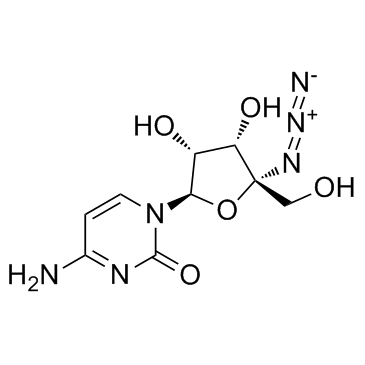| Cas No.: | 478182-28-4 |
| Chemical Name: | Cytidine, 4'-C-azido- |
| Synonyms: | R 1479;4'-Azidocytidine;R1479 |
| SMILES: | N(C1(CO)OC(N2C=CC(N)=NC2=O)C(O)C1O)=[N+]=[N-] |
| Formula: | C9H12N6O5 |
| M.Wt: | 284.2288 |
| Purity: | >98% |
| Sotrage: | 2 years -20°C Powder, 2 weeks 4°C in DMSO, 6 months -80°C in DMSO |
| Publication: | [1]. Klumpp K, et al. The novel nucleoside analog R1479 (4'-azidocytidine) is a potent inhibitor of NS5B-dependent RNA synthesis and hepatitis C virus replication in cell culture. J Biol Chem. 2006 Feb 17;281(7):3793-9. [2]. Smith DB, et al. Design, synthesis, and antiviral properties of 4'-substituted ribonucleosides as inhibitors of hepatitis C virus replication: the discovery of R1479. Bioorg Med Chem Lett. 2007 May 1;17(9):2570-6. |
| Description: | A potent, specific inhibitor of HCV NS5B polymerase and HCV replication (IC50=1.28 uM, replicon assay); shows no effect on cell viability or proliferation of HCV replicon or Huh-7 cells at >2 mM; inhibits RNA synthesis mediated by NS5B with IC50 of 320 nM, is the active form of Balapiravir (R-1479). |
| Target: | IC50: 1.28 μM (HCV replication)[1] |
| In Vitro: | R-1479 (R1479) inhibits HCV RNA replication with a mean IC50 value of 1.28 μM when measured as dose-dependent reduction of Renillaluciferase activity after a 72 h incubation of proliferating replicon cells. R-1479 shows no effect on cell viability or proliferation of HCV replicon or Huh-7 cells at concentrations up to 2 mM[1]. The most potent and non-cytotoxic derivative is R-1479 with an IC50 of 1.28 μM in the HCV replicon system. The triphosphate of R-1479 is prepared and shown to be an inhibitor of RNA synthesis mediated by NS5B (IC50=320 nM), the RNA polymerase encoded by HCV. R-1479 displays good activity in the replicon assay with no measurable cytotoxic or cytostatic effect[2]. |
| Kinase Assay: | The membrane-associated, native HCV replicase complex is isolated from 2209-23 HCV replicon cells and a derived cell line carrying HCV replicon RNA with a S282T mutation in the NS5B coding sequence. The in vitro replicase assay contain 10 μL of cytoplasmic membrane fraction, 50 mM HEPES (pH 7.5), 10 mM KCl, 10 mM dithiothreitol, 5 mM MgCl2, 20 μg/mL actinomycin D, 1 mM ATP, 1 mM GTP, 1 mM UTP, 30 μCi of [α-33P]CTP (3000 Ci/mmol, 10 mCi/mL), 1 unit/μL SUPERase•In, 10 mM creatine phosphate, and 200 μg/mL creatine phosphokinase in a final volume of 25 μL. Inhibition by nucleotide analogs is determined[1]. |
| Cell Assay: | The effect of R-1479 on the incorporation of tritiated thymidine into cellular DNA is measured using the [3H]thymidine incorporation scintillation proximity assay system. MTT and WST-1 assay systems are used to measure cell viability. The ATP bioluminescence assay kit HSII is used to measure intracellular ATP levels[1]. |
| References: | [1]. Klumpp K, et al. The novel nucleoside analog R1479 (4'-azidocytidine) is a potent inhibitor of NS5B-dependent RNA synthesis and hepatitis C virus replication in cell culture. J Biol Chem. 2006 Feb 17;281(7):3793-9. [2]. Smith DB, et al. Design, synthesis, and antiviral properties of 4'-substituted ribonucleosides as inhibitors of hepatitis C virus replication: the discovery of R1479. Bioorg Med Chem Lett. 2007 May 1;17(9):2570-6. |

 To enhance service speed and avoid tariff delays, we've opened a US warehouse. All US orders ship directly from our US facility.
To enhance service speed and avoid tariff delays, we've opened a US warehouse. All US orders ship directly from our US facility.




















